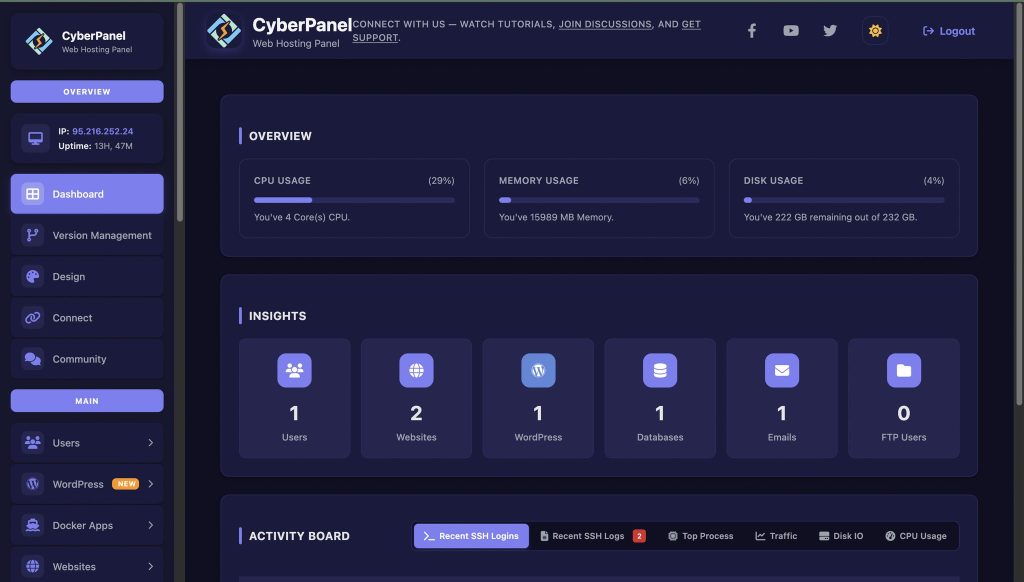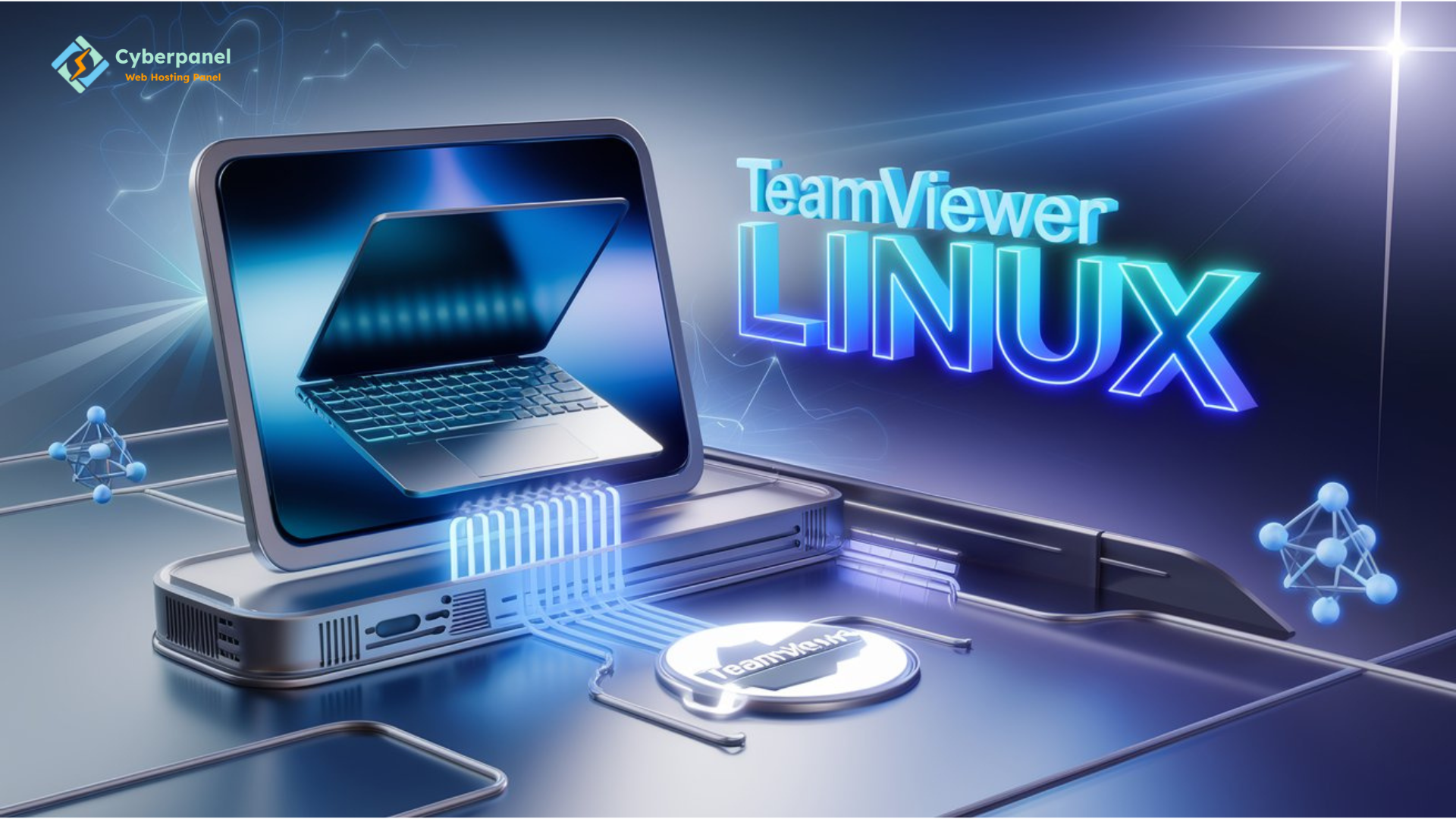TeamViewer for Linux continues to be a popular choice for remote access tools for individuals and organizations. It is quick, secure, and provides remote access to servers or desktop systems from anywhere across the globe. Whether you need to manage multiple systems, provide remote IT support, or access files from your home computer, TeamViewer for Linux facilitates cross-platform remote connectivity with ease.
In this guide, we will demonstrate how to install TeamViewer software on Linux Ubuntu, how to configure TeamViewer for remote access to other systems, and how to optimize your Linux experience with TeamViewer software. We will also cover alternatives, enterprise integration, and how you can use TeamViewer effectively with the CyberPanel server to remotely manage.
What is TeamViewer Linux?
TeamViewer Linux is the official version of TeamViewer, a widely used remote desktop software, which is built to run on the Linux operating system. TeamViewer software allows users to securely connect to another system over the internet, control the system remotely, share the screen, transfer files, or even conduct online meetings.
TeamViewer software is available for a variety of distributions, including:
- Ubuntu
- Debian
- Fedora
- openSUSE
- Red Hat Enterprise Linux
The native TeamViewer client for Linux is based on Qt and will work within each of the desktop environments, such as GNOME, KDE, or XFCE.
How to Install TeamViewer on Linux?
There are slightly different installation methods on various Linux distributions. Here are the details for a few:
Get exclusive access to all things tech-savvy, and be the first to receive
the latest updates directly in your inbox.
1. How to Install TeamViewer in Linux Ubuntu
Ubuntu users can install TeamViewer either through the .deb package or the terminal.
Step 1: Download TeamViewer
Visit the official TeamViewer Linux download page and get the .deb package for Ubuntu.
Alternatively, you can run:
wget https://download.teamviewer.com/download/linux/teamviewer_amd64.debStep 2: Install the Package
sudo apt install ./teamviewer_amd64.deb
Step 3: Launch TeamViewer
teamviewerOnce opened, you’ll see your TeamViewer ID and password, which are required for connecting to or allowing remote access.
2. How to Install TeamViewer on Debian
For Debian users, installation is nearly identical:
wget https://download.teamviewer.com/download/linux/teamviewer_amd64.deb
sudo dpkg -i teamviewer_amd64.deb
sudo apt --fix-broken install
3. How to Install TeamViewer on Fedora, RHEL, or openSUSE
These distributions use RPM packages:
sudo dnf install https://download.teamviewer.com/download/linux/teamviewer.x86_64.rpm
or for older systems:
sudo yum install teamviewer.x86_64.rpm
Once installed, start TeamViewer via terminal:
teamviewer
How to Launch TeamViewer on Linux
You will be able to initiate remote sessions quickly once you’ve installed it.
- Launch TeamViewer
You will see your TeamViewer ID and temporary password. - Connect to a Remote Device
To connect to the remote device, enter the TeamViewer ID of the remote device in the “Partner ID” box. - Authorization
Enter the password provided by the remote device user. - Accessing and Controlling the Remote Device
You can now control the remote device, exchange files, or assist the remote device with troubleshooting.
Running TeamViewer from CLI
TeamViewer for Linux also has a CLI (Command Line Interface), which may be best suited for headless setups or servers.

Examples:
sudo teamviewer daemon start
Get the current TeamViewer ID:
sudo teamviewer info
Set a permanent password for unattended access:
sudo teamviewer passwd yourpassword
Stop the TeamViewer daemon:
sudo teamviewer daemon stop
Set Up Unattended Access in TeamViewer Linux
Unattended access allows you to connect to a Linux machine without the need for confirmation every time.
- Open TeamViewer → Extras → Options
- Go to the Security tab
- Enable “Grant Easy Access”
- Create a personal password to log in remotely
- Link it to your TeamViewer account
This is especially useful if you have a server or workstation that you will need access to at any time.
How to Update TeamViewer on Linux
Keeping TeamViewer updated ensures better performance and security.
Using apt on Ubuntu/Debian
sudo apt update
sudo apt upgrade teamviewer<br>Using dnf on Fedora
sudo dnf upgrade teamviewer
How to Remove TeamViewer from Linux
If you ever need to uninstall it:
sudo apt remove teamviewer
or for RPM-based systems:
sudo dnf remove teamviewer
Troubleshooting TeamViewer on Linux
| Issue | Solution |
|---|---|
| TeamViewer won’t start | Restart the daemon: sudo teamviewer daemon restart |
| No network connection | Check firewall or proxy settings |
| Black screen on remote access | Disable hardware acceleration in settings |
| Authentication failed | Ensure password and partner ID are correct |
Alternatives to TeamViewer for Linux
| Tool | Description |
|---|---|
| AnyDesk | Lightweight and fast remote access tool. |
| Remmina | GNOME-based remote desktop client supporting RDP, VNC, and SSH. |
| Chrome Remote Desktop | Browser-based remote access by Google. |
| NoMachine | High-performance remote desktop with media support. |
While these alternatives are useful, TeamViewer for Linux remains more feature-rich for cross-platform enterprise environments.
Best Practices for Linux TeamViewer Security
- For safe remote access:
- Turn on Two-Factor Authentication (2FA)
- Choose unique passwords with complexity
- Allow access only to trusted devices
- Make sure you keep a version of TeamViewer updated
- Use the whitelist function to allow devices to connect to you
TeamViewer for Linux with CyberPanel

CyberPanel is a contemporary web hosting control panel that operates on Linux servers. Along with TeamViewer Linux, it provides full-access control of your server environment – whether locally or remotely.
How They Work Simultaneously
- Remote CyberPanel Access: Connect via TeamViewer in order to manage websites, SSL or DNS.
- Server Maintenance: Remotely access headless Linux servers through GUI tools.
- Security Checks: Troubleshoot firewalls or mail issues while viewing logs in real time.
- Automation: Combine SSH scripts and align them to the CyberPanel task when accessing via a TeamViewer session.
Thus, TeamViewer on Linux Ubuntu is extremely powerful for developers or system admins who manage to control cloud-based servers.
Final Thoughts!
TeamViewer Linux is still one of the most effective, secure, and convenient solutions for remote connectivity. Not only does it offer connectivity between systems or platforms, but it also ensures you can manage devices, provide support, or access files globally. Supporting Ubuntu, Debian, Fedora, and many more – this is a must-have for personal and professional users.
Whether you are an educator managing remote labs, an IT admin working on behalf of global clients, or a CyberPanel user managing web-based servers, TeamViewer for Linux is the solution that offers both stability and flexibility.
Ready to experience secure, cross-platform remote control that is built for professionals and creators alike? Download and install TeamViewer Linux today!
People Also Ask
How can I run TeamViewer on a headless Linux server?
Use the command-line interface and enable unattended access via teamviewer daemon start and teamviewer passwd yourpassword.
Can I use TeamViewer to connect from Linux to Windows or macOS?
Absolutely. TeamViewer is fully cross-platform and supports all major operating systems.
Does TeamViewer Linux require a GUI?
Not always. It can run headlessly with CLI for remote administration or server access.



